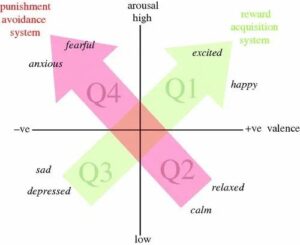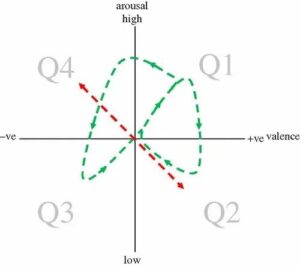I was fortunate enough to meet Dr Jaak Panksepp at the Art and Science of Animal Training Conference in March 2014. His basic view of behavior before considering the primitive emotional states is that all behavior is built upon a very simple thought. Most animals generate behavior on a single axis (valence) that avoids fear/stress/pain on one end and approaches or anticipates reward/pleasure on the other. This saves endless discussion about theoretical internal drives. Most believe drives are actual internal mechanisms of behavior, but it is more of a layman’s term for simple understanding of complex interaction of the animal/dog’s internal physiology and psychology (for more understanding of the fallacies of “drive” please read 2015 Drive in Additional Resources on the Puppy Development tab).
With resilience we want to consider the consistency of the dog’s performance that will shape behavioral pathways.
An excellent illustration of this was given in the free preview video course by Illis Animal Behaviour Consulting/ Karolina Westlund, PhD. This is the course that I let everyone know about on our Facebook page. It is still available, but is no longer free (https://illis.se/education/courses/emotion-fundamentals/ ). Dr Westlund introduces us to Core Affect Space. Using diagrams from Mendel, Burman, and Paul (2010, https://royalsocietypublishing.org/doi/full/10.1098/rspb.2010.0303) she explains the four quadrants to consider:

We obviously want our dogs to spend the most time in Quadrant 1. There are times we may want Quadrant 2 (rest, travel, or low arousal repetitions), but a detection dog stuck in that quadrant is rarely selected as a training candidate. During training the dog may move to quadrants 3 or 4, but want to get the dog back into quadrant 1 and quickly as possible.

The main thing we want is a dog that stays in the higher arousal and in anticipation of reward with natural character and the least effort. Recovering from stress or startle is acceptable. Dogs that have to be “begged” or “milked” through a poor response without recovery are not likely candidates for detection roles with law enforcement.

